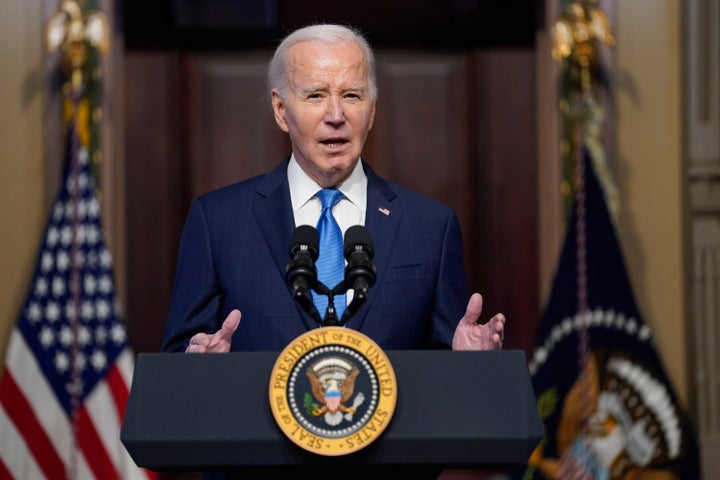Joe Biden has an attention problem.
The president and his team have never aimed to dominate the news cycle in the style of his predecessor and likely 2024 challenger, Donald Trump. They’ve often been happy to take a policy win — taking Social Security cuts off the board in debt limit talks, for instance — over keeping a weapon in hand to hammer the GOP with. Other times, they’ve been happy to let an increasingly authoritarian and chaotic GOP alienate the electorate without interference. Biden generally avoids one-on-one interviews, which his team views as providing little upside but containing high risk for gaffes.
As Biden opens the calendar year of his reelection, the downsides of this strategy may be coming into view: The president, who is essentially tied with Trump nationally and often trails the Republican in polls of key swing states, has left little to no impression with less-engaged voting blocs, including young people, voters who didn’t cast ballots in the 2022 midterm election and Black and Latino voters without a college degree — all groups which, at the moment, are giving Biden less support than they did four years ago.
The result is a blank slate of a presidency, according to interviews with multiple Democratic strategists. Voters, they say, have minimal knowledge of Biden’s accomplishments and even less of a sense of his plans, hopes and aspirations for the country.
Evan Roth Smith, a partner at the Democratic consulting firm Slingshot Strategies, noted Biden’s working-class “Scranton Joe” persona, built over five decades in politics, has essentially disappeared.
“His entire persona has basically been whitewashed,” said Smith, who serves as the lead pollster for Blueprint, which aims to provide messaging advice to Democrats ahead of the 2024 election. “We have a tabula rasa president right now. He’s just being defined by whatever pops in the news cycle.”
The latest iteration of The New York Times/Siena College poll, the preeminent driver of Democratic anxiety since its inception, sums up the issue quite well: Biden led by six percentage points among people who cast ballots in the 2022 midterms, but was losing among those who did not vote in the midterms by a whopping 22 percentage points. The result? Biden is winning among likely voters by a 47% to 45% margin, but trails among registered voters by a 46% to 44% margin.
Those margins are obviously surmountable, and Trump remains just as unpopular with the electorate as Biden. But for Biden to win over more voters and cement his support, his campaign will need to actually get the electorate to pay attention to his popular-on-paper policy accomplishments on everything from gun control to climate change, which has so far eluded the White House and his political operation.

The first element of Biden’s plan will begin on Friday and Monday, when he will deliver a pair of speeches aimed at raising the stakes of the election. His speech in Valley Forge, Pennsylvania, on Friday will focus on President Donald Trump’s role in the Jan. 6, 2021, insurrection, and one on Monday at Mother Emanuel AME Church in Columbia, South Carolina, the site of a 2015 mass shooting committed by a white supremacist.
“This election will determine the future of American democracy and every American’s fundamental freedoms,” Michael Tyler, the campaign’s communications director, said on a call with reporters earlier this week.
Another official, deputy campaign manager Quentin Fulks, added: “By the time voters are thinking about the election more, our campaign will be in full swing.”
The campaign is already spending tens of millions of dollars on television ads they hope will at least provide insights into how to reach these voters, who live in an ultra-fragmented media environment where they can avoid most political messaging — and usually don’t believe the political messages that do make it through.
“The voters who haven’t tuned in yet are more tuned out than anyone in this conversation can possibly conceive of. Politics does not enter their list of interests at all,” a senior Biden campaign official, who requested anonymity to speak frankly about campaign strategy, told HuffPost. “They are super not paying attention yet.”
The campaign’s plan for reaching these often unreachable voters is being tested now in Arizona and Wisconsin, where they are running relational organizing pilots built around giving volunteers the ability to persuade their friends and family to back Biden and turn out to vote. The Arizona project is focused on Latino voters, while the Wisconsin operation is focused on young people and Black voters.
It’s clear those volunteers will have a lot of work to do — and potentially a lot to work with.
In late 2023, two groups on the opposite ends of the Democratic Party’s ideological divides — the Progressive Change Campaign Committee and Blueprint, which is backed by centrist megadonor Reid Hoffman — released polling showing essentially the same thing: Voters know very little about many of Biden’s most theoretically popular accomplishments.
For instance, Biden’s fight against so-called “junk fees” attached to airline and concert tickets, checking accounts and hotel reservations is extremely popular with a cost-conscious public, with PCCC finding 85% of likely 2024 voters support his push to ban or limit them. But only 16% of likely voters had “heard a lot from President Biden” on the issue. Similar gaps existed on lowering the cost of insulin, giving Medicare the power to negotiate prescription drug prices and even on high-profile Biden victories like the bipartisan infrastructure package.
Of course, the groups took their recommendations in different directions: Blueprint encouraged Biden to brush aside intra-party politics and embrace policy achievements that would alienate many liberals: increasing oil production to all-time highs and cracking down on undocumented immigrants attempting to claim asylum after crossing the U.S.-Mexico border.
PCCC, on the other hand, was trying to find a message the entire party could jointly deliver, and recommended a message focused on increasing taxes on the wealthy and protecting or expanding Social Security.
Still, Democrats and the Biden campaign can’t simply assume voters will naturally learn only the most popular things Biden has done — after all, the Trump campaign will soon be spending millions attacking Biden rather than former South Carolina Gov. Nikki Haley or Florida Gov. Ron DeSantis. And to blame the deficit entirely on a lack of attention paid by voters is perhaps too flattering to both liberal sensibilities and the Biden administration’s accomplishments.
In Blueprint’s polling, Smith noted there was little evidence voters who paid more attention to politics were actually more impressed with what Biden has done than other voters.
“There is no other shoe to fall,” he said. “There’s no evidence less partisan voters, once they read up on the guy and engage in the election, are going to instantly improve things for the president.”

